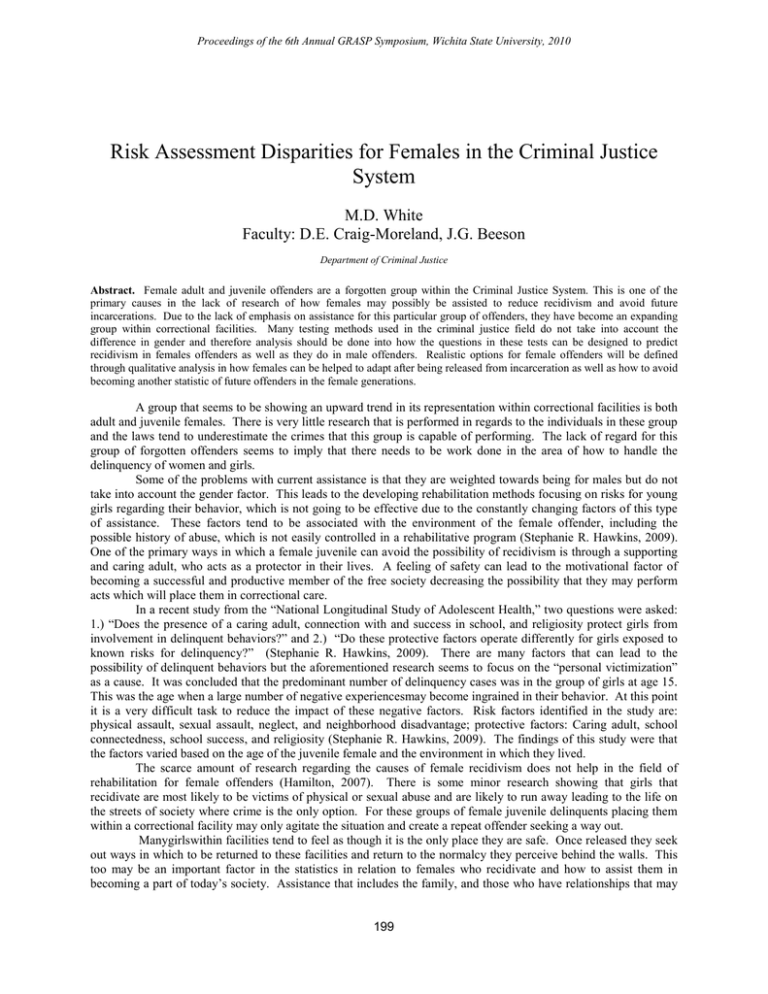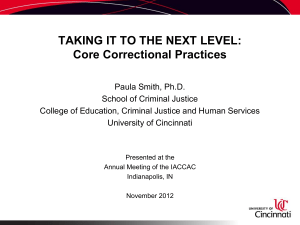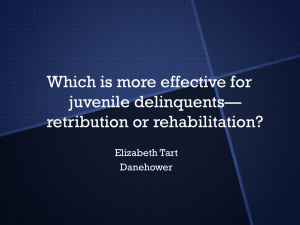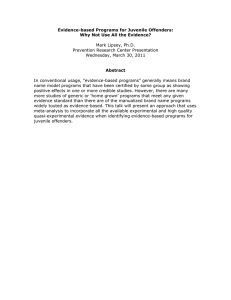Risk Assessment Disparities for Females in the Criminal Justice System M.D. White
advertisement

Proceedings of the 6th Annual GRASP Symposium, Wichita State University, 2010 Risk Assessment Disparities for Females in the Criminal Justice System M.D. White Faculty: D.E. Craig-Moreland, J.G. Beeson Department of Criminal Justice Abstract. Female adult and juvenile offenders are a forgotten group within the Criminal Justice System. This is one of the primary causes in the lack of research of how females may possibly be assisted to reduce recidivism and avoid future incarcerations. Due to the lack of emphasis on assistance for this particular group of offenders, they have become an expanding group within correctional facilities. Many testing methods used in the criminal justice field do not take into account the difference in gender and therefore analysis should be done into how the questions in these tests can be designed to predict recidivism in females offenders as well as they do in male offenders. Realistic options for female offenders will be defined through qualitative analysis in how females can be helped to adapt after being released from incarceration as well as how to avoid becoming another statistic of future offenders in the female generations. A group that seems to be showing an upward trend in its representation within correctional facilities is both adult and juvenile females. There is very little research that is performed in regards to the individuals in these group and the laws tend to underestimate the crimes that this group is capable of performing. The lack of regard for this group of forgotten offenders seems to imply that there needs to be work done in the area of how to handle the delinquency of women and girls. Some of the problems with current assistance is that they are weighted towards being for males but do not take into account the gender factor. This leads to the developing rehabilitation methods focusing on risks for young girls regarding their behavior, which is not going to be effective due to the constantly changing factors of this type of assistance. These factors tend to be associated with the environment of the female offender, including the possible history of abuse, which is not easily controlled in a rehabilitative program (Stephanie R. Hawkins, 2009). One of the primary ways in which a female juvenile can avoid the possibility of recidivism is through a supporting and caring adult, who acts as a protector in their lives. A feeling of safety can lead to the motivational factor of becoming a successful and productive member of the free society decreasing the possibility that they may perform acts which will place them in correctional care. In a recent study from the “National Longitudinal Study of Adolescent Health,” two questions were asked: 1.) “Does the presence of a caring adult, connection with and success in school, and religiosity protect girls from involvement in delinquent behaviors?” and 2.) “Do these protective factors operate differently for girls exposed to known risks for delinquency?” (Stephanie R. Hawkins, 2009). There are many factors that can lead to the possibility of delinquent behaviors but the aforementioned research seems to focus on the “personal victimization” as a cause. It was concluded that the predominant number of delinquency cases was in the group of girls at age 15. This was the age when a large number of negative experiencesmay become ingrained in their behavior. At this point it is a very difficult task to reduce the impact of these negative factors. Risk factors identified in the study are: physical assault, sexual assault, neglect, and neighborhood disadvantage; protective factors: Caring adult, school connectedness, school success, and religiosity (Stephanie R. Hawkins, 2009). The findings of this study were that the factors varied based on the age of the juvenile female and the environment in which they lived. The scarce amount of research regarding the causes of female recidivism does not help in the field of rehabilitation for female offenders (Hamilton, 2007). There is some minor research showing that girls that recidivate are most likely to be victims of physical or sexual abuse and are likely to run away leading to the life on the streets of society where crime is the only option. For these groups of female juvenile delinquents placing them within a correctional facility may only agitate the situation and create a repeat offender seeking a way out. Manygirlswithin facilities tend to feel as though it is the only place they are safe. Once released they seek out ways in which to be returned to these facilities and return to the normalcy they perceive behind the walls. This too may be an important factor in the statistics in relation to females who recidivate and how to assist them in becoming a part of today’s society. Assistance that includes the family, and those who have relationships that may 199 Proceedings of the 6th Annual GRASP Symposium, Wichita State University, 2010 become an important part of the gender-specific programs to help young female delinquents.Only through understanding gender differences can society help the female juvenile delinquents who find themselves within the justice system. Important gender factors can include: pregnancy, motherhood, sexual abuse, sexual assault, domestic violence, and depression. These factors are identified as more influential in how females cope with their situation. There has been some “gender-responsive treatment approach” developed since the realization of these influential factors (Poels, 2007). Through the development of gender appropriate rehabilitation, successful help can be given to female juvenile offenders giving them the assistance they need. Risk assessment predictors for recidivism based on gender can help identify the high risk and low risk offenders, and help increase the effectiveness of assistance for female offenders. A list of questions in relation to the specific parts of the juvenile’s life can help professionally trained individuals in breaking the problems of “antisocial personality patterns” (Poels, 2007). Still so many programs seem to simply modify assessments for boys to use for girls and this does not help in predicting the future behavior of young female juvenile offenders. Offense categories in which female juveniles are having rate increases is in simple assault, drug abuse violations, liquor law violations, driving under the influence, and disorderly conduct. These statistics in 2006 showed that the number of juveniles arrested who were female was 30% (Hamilton, 2007). Females are generally perceived by society to be the victims of crime due to issues that are exclusive to their gender. These issues include pregnancy, motherhood, sexual abuse, sexual assault, domestic violence, and depression. These issues for females have led society to begin to conclude that this group of offenders may require “gender-responsive treatments” to assist them in dealing with their problems (Poels, 2007). Yet despite the new concern for female offenders, research for this group has been largely ignored or neglected. Due to the lack of rehabilitative assistance prior to release, the percentage of incarcerated females has been increasing over the last few decades at a rate of 500 percent (Heilbrun, DeMatteo, Fretz, Erickson, Gerardi, & Halper, 2008). In 2006, the U.S. Department of Justice made a review of the figures associated with correctional populations. Its findings show that the number of female offenders held in correctional facilities increased by 4.5 % in relation to the fact that male correctional inmates increased by 2.6%. The final statistics show that by the end of 2006 females were 7.2% of all prison inmates, an increase from 6.1 percent in 1995 (Heilbrun, DeMatteo, Fretz, Erickson, Gerardi, & Halper, 2008). This means that there will be a large percentage of females released back into their communities, where they account for 9.9 percent of entries in the parole system. The alarming facts of this information is that this is an increase of 2 percent from 1990 and these percentages increase at an alarming rate as the years progress. Also alarming is the fact that the recidivism rates for this group are excessive. Recent statistics show that after one year 34.5 percent are likely to recidivate, and after 3 years, 46.3 percent are likely to commit another crime (Heilbrun, DeMatteo, Fretz, Erickson, Gerardi, & Halper, 2008). Consequently, there is a cry for gender-specific programs within the correctional community that takes into account all factors related to the rehabilitative return of female offenders to society. Through proper risk assessment testing, early intervention can stop delinquent behavior and help create individuals become a viable part of society. Few services are available for young girls between the age of 8 to 11 and at this important step helping the developing minds of these young girls will create an environment suitable for growing and learning. By providing the gender-based community services, society becomes an important part of the intervention and can give hope that the juveniles will be able to escape a possibly harmful environment. These services can include family counseling, substance abuse prevention, specialized educational services and mentoring services (Acoca, 1999). This could include an all-girls school environment, which, although controversial, would allow girls to learn without distraction or fear. This can create an environment that is very therapeutic and can promote public safety while bringing about a reduction to recidivism,and the simple statistics of first-time delinquent girls who may become future women inmates. [1] Stephanie R. Hawkins, P. W. (2009, January). Girls Study Group: Understanding and Responding to Girls' Delinquency. OJJDP , 1-1 [2] Hamilton, B. M. (2007). Girls Will Be Girls. Journal of Contrmporary Criminal Justice , 341-362. [4] Poels, V. (2007). Risk Assessment of Recidivism of Violent and Sexual Female Offenders. Psychiatry, Psychology and Law , 227-250. [5] Heilbrun, K., DeMatteo, D., Fretz, R., Erickson, J., Gerardi, D., & Halper, C. (2008, March 1). Criminal recidivism of female offenders: The Importance of Structured, Community-Based aftercare. Retrieved January 22, 2009, from access my library: http://www.accessmylibrary.com/coms2/summary_0286-34479996_ITM [6]Acoca, L. (1999). Investing in Girls: A 21st Century Strategy. Journal of the Office of Juvenile Justice and Delinquency Prevention, VI (1), 3-13. 200





